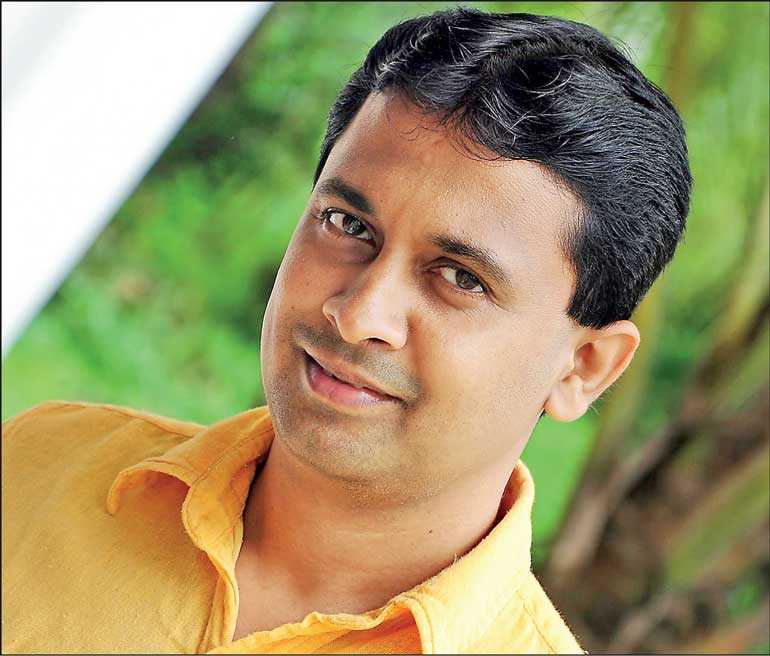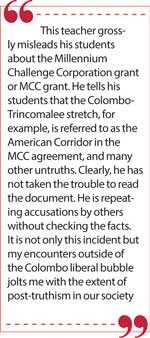Monday Nov 17, 2025
Monday Nov 17, 2025
Friday, 8 November 2019 00:00 - - {{hitsCtrl.values.hits}}

A recent encounter with one of the ‘inspirational’ videos by a popular tuition master, Tissa Jananayake,  brought home the extent to which post-truth has pervaded cultural life in Sri Lanka. This teacher grossly misleads his students about the Millennium Challenge Corporation grant or MCC grant.
brought home the extent to which post-truth has pervaded cultural life in Sri Lanka. This teacher grossly misleads his students about the Millennium Challenge Corporation grant or MCC grant.
He tells his students that the Colombo-Trincomalee stretch, for example, is referred to as the American Corridor in the MCC agreement, and many other untruths. Clearly, he has not taken the trouble to read the document. He is repeating accusations by others without checking the facts. It is not only this incident but my encounters outside of the Colombo liberal bubble jolts me with the extent of post-truthism in our society.
What is going on? Sometime back I wrote about the Grand Canyon that separates the English-speaking Elite (ESE) and the non-ESE in Sri Lanka. To bridge the gap somebody’s got to walk across the canyon, and I think it is the ESE who should. That includes myself, my friends and family, and you the reader who is perusing this English script with ease.
The non-elites have not been served well by either major party. Mahinda Rajapaksa came to power on the populist Jathika Chinthana ideology but ended up creating a class of greedy ‘new rich’. The 2015 transformation disappointed those behind it by seemingly using the Yahapalana ideology to re-energise a class of greedy ‘old rich.’
To survive in a post-truth era what we need is a leadership team that can bridge the Yahapalana and Jathika Chinthana ideologies.
The selection of Sajith Premadasa as the presidential candidate over Ranil Wickremesinghe is a first step. Whether the Sajith team is the best to bridge the Yahapalana and Jathika Chinthana ideologies, the reader can decide. I like to elaborate on how this bridge might work.
Oxford dictionary named post-truth as the 2016 word of the year. According to their definition, post-truth is “an adjective relating to circumstances in which objective facts are less influential in shaping public opinion than emotional appeals”. One place where this is evident in is our classrooms or tuition classes.
Jathika Chinthana pseudoscience
Biology curriculum for the GCE A/L examination is a huge compendium of facts which reduces teaching process to essentially a guide to absorb the facts. The tuition teachers seem to do this well. 
Tissa Jananayake, for example, makes the Dr. Shafi hoax an occasion to teach about the fertilisation process of a human egg and how it occurs within the fallopian tubes. He gives students a good feel for the size and the fragility of fallopian tubes in the context of a high likelihood of somebody wilfully pinching the minute tube.
In the video dated June 2019, the teacher goes on to describe the extent of properties held by Dr. Shafi, the number of operations conducted by him, his credentials, etc., all based on hearsay. As it turned out, many of those allegations were not true.
Fact check is a basic tenet of science. A good set of videos selected by the Department of Education can do the job giving the students a good sense of the proportion and other properties of fallopian tubes without allowing these random tuition masters to veer into misinformation and propaganda. More importantly, a reduction in the content in the curriculum is sorely needed.
A lesson on microbes brings up the real issue behind these bizarre behaviours of science teachers. The real issue, I believe, is the discomfort of some teachers of science or students of science about the scientific truths seemingly coming down to them from the West. So, they resort to stories that ‘prove’ that all these discoveries were made by the locals, the Sinhalese to be specific, many thousands of years ago.
In the microbiology lesson, King Dutgemunu is the real discoverer of antibiotics but a certain Alexander Fleming takes the credit, the teacher says. To support, the teacher relates an interesting story about kavum, our traditional sweetmeat. A similar story was published in Daily mirror and I quote it here:
“Even though the word ‘antibiotics’ wasn’t invented until less than a century ago, the use of substances with antibiotic properties has a much longer history. For an example, it’s said that in preparing for battle, the army of King Dutugemunu, famous Sri Lankan King who ruled during Anuradhapura era, used to prepare kevum (oil cakes) months in advance and keep them exposed to air so the mould can grow on them. Later, they were used to prepare a poultice to apply on battle wounds to prevent them from festering.”
This is well and good. The mould on kavum may indeed have had antibiotic properties. But to dismiss a scientist who extracted the specific substance leading to mass manufacture and saving of millions of lives is not okay.
The second story is a study, apparently conducted by the lecturer and a University of Colombo professor, about the construction of labour rooms in old elite houses or walauwas in Sri Lanka. Apparently, the material used repelled microbes, making child birth safer.
Jathika Chinthana for real science
The positive take away for me from these bizarre lectures is the importance of connecting science to folklore and stories that make students connect to the subject matter. This is what I call Jathika Chinthana for real science.
These stories and even the Natha God story by Nalin de Silva and his team investigating the cause of kidney disease in Sri Lanka has real potential for contextualising liberal Western science tradition. But it cannot be at the expense of scientific thinking, which I believe is not the property of ancient civilisations or Western liberals but the collective heritage of humanity.
One nation or one group of people cannot take credit for the gift of science to society today. Science knowledge base is a world heritage. The centres of science may have moved from Mesopotamia Mohenjo-Daro in prehistoric times, to Europe and America to produce a Steve Jobs in recent times, but that Steve Jobs is really a product of the knowledge base accumulated through the ages.
As Google says, each new discoverer is standing on the shoulders of other giants. There may not be a direct link between King Dutugemunu’s ‘pus kavun’ theory and Alexander Fleming’s antibiotic theory, but inspirations for discoveries do not come in a vacuum. They are shaped by the society and scientific establishment prevalent in society at that time. 
Societies are not islands. They build on knowledge of others dating back to first man or woman who discovered fire. Our science teachers indeed should always try to give children their due place in world heritage of science.
In sum, science cannot be taught in a vacuum. It must be taught in reference to the local context and culture to make our science education our own. The Ravana story, for example, must be an essential part of science education, I think. However, telling of that story and making the connections should not be left to random tuition masters. A booklet looking at the Ravana story from respectful but scientific approach should be made part of the curriculum.
Could there have a prehistoric kingdom which is now buried under water? How feasible was it to have a Dadumonara (or a flying machine) at that time or is the story a symbolic reference to the king’s powers? To me, Jathika Chinthana-infused science is having these stories in our curriculum to make the subject real for our children.
The cry for a unique identity
What I hear behind the Sri Lankan version post-truths is a cry for a national identity which is not defined by Western liberal culture.
Milinda Moragoda in his centre-page article in the Lankadeepa of 6 November uses the term Macaulay class to describe those holding Western liberal values devoid of links to the local culture. He is referring to Thomas B. Macaulay, a 19th century colonial administrator whose ideas on dealing with natives in the colonies has apparently led to generations of brown clones of the colonisers.
Milinda Moragoda argues that there is new class of youth confident in dealing with the West on their own terms within a national identity. I sure wish that is true.